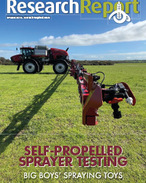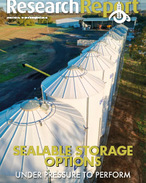This article is 9 years old. Images might not display.
For the past four years the space-age polymer has been tested and proven to be very easy to apply by farmers with portable hand-held spray kits or with conventional machine spraying systems for larger areas.
The ongoing research trials in New South Wale’s Murrumbidgee Irrigation Area near Griffith are about to be beefed up for commercial assessment on properties growing melon and tomato crops at Finley and Mildura on the Victoria-NSW border.
The team at CSIRO are focused on refining the biodegradable polymer membrane so it can be sprayed directly to large areas of soil, limiting limit evaporation as crops are planted and lasting up to four months.
Other variations on the same theme are being considered to cover paddocks for a year or more during unseeded or production phases.
The polymer is coloured black for crop use, to restrict sunlight penetrating the membrane and promoting weed growth between planted rows. Mr Robertson said the industrial-based polymer product could also potentially contain herbicide as a weed control option or beneficial nutrients and enzymes.
Project leader and internationally recognised soil physicist, Keith Bristow at CSIRO in Townsville said the membrane effectively worked as a weed mat and moisture retainer, not unlike a sheet of black plastic spread on the ground, but with a far shorter lifespan.
Bristow said the aim was to provide a temporary barrier to improving the amount of soil water available for plant growth until a dense leaf canopy grows to shade the ground and naturally reduce evaporation and weed activity.
The soil physicist said the opportunities for producing crops with less water and weed was exciting.
“We’ve got people queuing up with ideas about all sorts of potential applications and even partenerships,” Mr Bristow said.
“We’d like to think it could be ready for the market in 18 months to two years, depending on how our next stage of trials progress,” he said.
The Townsville CSIRO scientist said the spray process did not completely seal the paddock surface with the membrane, particularly where lumps of earth, sticks or wheel tracks could create gaps.
“But that’s not bothering us. Holes allow oxygen to enter the soil – we are very conscious of protecting soil microbiology.”
It is likely the new membrane technology will be used in numerous broadacre cropping situations, the CSIRO was deliberately taking its time to scale up trials in high value field crops next month, to ensure the expensive input costs of the project were covered by improved yields and crop returns.
Different climate zones will be tested to assess how quickly the polymer degrades in different soil, temperature and rainfall conditions, while the impact of any fine residue eaten by livestock is also being studied.
CSIRO researchers also want to develop a much hardier version of the sprayed-on membrane to line irrigation water channels and storage prone to seepage losses.























